| As you create your Web site on your computer, you keep it in a local site folder (Section 14.1.1.4), often called a local site for short. You can think of a local site as a work-in-progress. As your site is under construction ”whether you're building it from scratch or adding and modifying pages ”you'll routinely have partially finished documents sitting on your computer. Then, when you've perfected and tested your pages using the techniques described in Chapter 15, you're ready to transfer them to a Web server that's connected to the Internet. Dreamweaver refers to the Web-server copy of your files as the remote site , and the program provides five methods for transferring files between it and your local site: -
FTP. By far the most common method is FTP , or File Transfer Protocol. Just as HTTP is the process by which Web pages are transferred from servers to Web browsers, FTP is the traditional method of transferring files over the Internet, and it's the one to use if a Web-hosting company or Internet Service Provider (ISP) provides the home for your Web pages. -
Over the local area network. If you're working on an intranet, or if your company's Web server is connected to the company network, you may also be able to transfer files just as you would any files on your office network (using the Network Neighborhood, My Network Places, Chooser, or Connect to Server command, depending on your operating system), without even connecting to the Internet. -
The last three options ” RDS, SourceSafe, and WebDAV ”are advanced file management systems used for collaborative Web development. They're discussed in Section 16.1.3. 16.1.1 Setting Up a Remote Site with FTP You can set up a remote site only if you've first set up a local site on your computer. Even if you're just putting up a temporary site while working on your real Web site, you must at least have the temporary site constructed and defined in Dreamweaver (see Section 14.1.1). FREQUENTLY ASKED QUESTION
Beyond Dreamweaver Do I have to use Dreamweaver to move my files to the Web server? No. If you're used to using another program for this purpose, such as CuteFTP (Windows) or RBrowser (Mac), you can continue to use it and ignore Dreamweaver's Remote Site feature. However, if you've never before used Dreamweaver to move files to a server, you may want to at least try it; you'll find that Dreamweaver simplifies much of the process. For example, when you want to move a file from your computer to the Web server using a regular FTP program, you must first locate the file on your local machine and then navigate to the proper folder on the Web server. Dreamweaver saves you both steps; when you select the file in the Files panel and click the Put button, Dreamweaver automatically locates the file on your computer and transfers it to the correct folder on the Web server. |
NOTE Dreamweaver MX 2004 lets you edit directly on pages located on a Web server, using an FTP connection (or if you're working with Cold Fusion files, an RDS connection). This new feature isn't always the best way to go: It's slow, and leaves your works-in-progress open for the world to see on the Internet. Once that's done, here's how you go about creating an Internet-based mirror of your local site folder: -
Choose Site  Manage Sites. Manage Sites. The Manage Sites dialog box opens, listing all sites that you've defined so far. You're about to create a living, Internet-based copy of one of these hard drive-based local sites. -
Click the name of the site you want to post on the Internet, and then click Edit. Alternatively, just double-click the site name in the list. The Site Definition window appears for the selected site, as shown in Figure 16-1.  | You can also define the remote site and the local site simultaneously , when you first begin creating a Web site (as described in Section 14.1.1). Even then, however, Dreamweaver requires that you first give the site a name and choose a local root folder. At that point, you rejoin the steps described here. | |
If a Web hosting company or ISP will host your Web site, you'll use FTP to put your site on the Web. To make sure you have all the information you need to connect to the Web server, ask your ISP for these four pieces of information: (1) the FTP host name of the server, (2) the path to the root directory for your site (3) your login name and (4) your password. (If the Web server comes with your email account, your login and password may be the same for both.) 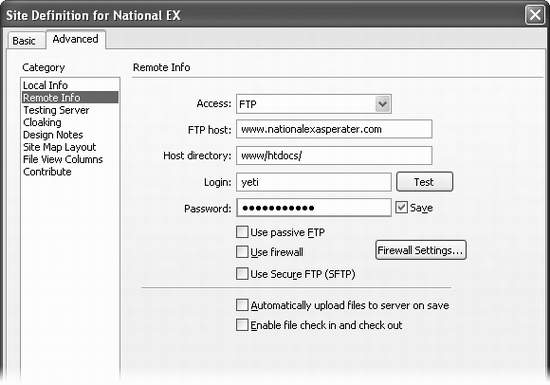 -
Click the Advanced tab. You can also use the Site Definition Wizard (Basic tab) to set up a remote site. However, since the wizard requires you to step through screen after screen of setup information ”even after you've already supplied most of it ”the Advanced tab is faster. -
In the Category panel, click Remote Info . From the Access pop-up menu, choose FTP. The Site Definition window now shows menus and fields for collecting your connection information (see Figure 16-1). -
Fill in the FTP Host field. Your FTP host name may be a name like www.nationalexasperater.com or ftp. nationalexasperater.com. It never includes directories, folders, or slashes (like www.nationalexasperater.com/home ), never includes codes for the FTP protocol ( ftp://ftp.nationalexasperater.com ), and is never only a domain name, such as nationalexasperater. com. It might also be an IP address, like 64.226.43.116. In most cases, it's the address you would enter into a Web browser (minus the http:// ) to get to your site's home page. If you don't know the host name, there's only one way to find out: Call your Webhosting company or ISP or check its Web site. -
In the Host Directory field, type the path to the root directory. You're specifying which folder within your Web hosting account will contain your Web page files and serve as the root folder for your site. Just as on your own hard drive, all the files of your Web site on the Web will be completely contained inside a master folder referred to as the root folder. But when you connect to your Web server using FTP, you're rarely connected to the root folder itself. Instead, you usually connect to a folder that isn't accessible over the Web ”some administrative folder for your Web account, often filled with folders for log reports of your site's Web traffic, databases, and other files not visible over the Web. UP TO SPEED
Make Wizard Disappear with One Click Dreamweaver's Site Definition Wizard makes the process of defining a new site easy. You encountered it in Chapter 1 (Section 1.3.1). If you're defining a new site and you already have a remote site set up on a Web server, you can go ahead and use the wizard to add all of your remote login information. Once the site definition is done, you can immediately start transferring files to the server. The information requested by the wizard is exactly the same as described in the instructions on these pages. However, if you've already defined a Web site, it's a lot easier to click the Advanced tab. This way, you can skip all of the information you've already supplied and jump immediately to the Remote Information category.

|
Your hosting account's root directory folder (or even a folder within it) is where you place your site's root folder; that's why you're typing its name here. Common names for the root folder at ISPs or Web-hosting companies are docs, www, htdocs, public_html, or virtual_html. (Call your Web hosting company or ISP to find out.) The information you give Dreamweaver here represents the path from the FTP folder to the root folder. It may look like this: www/htdocs . In effect, you're telling Dreamweaver: "After connecting to the Web server, you'll find a folder named www. Inside this folder is another folder, htdocs. Put my site files in there." In other words, htdocs is the Web site's root folder on this particular remote hosting account. -
In the Login field, type your user name; type your password in the Password field. Dreamweaver uses bullets ( ) to display your password so that passing evildoers in your office can't see what you're typing. If you want Dreamweaver to remember your password each time you use the program, turn on the Save checkbox. This way, you won't have to type your password each time you connect to the Web server. NOTE For security reasons, don't turn on the Save box if you access the Web using computers at, say, your local library, or anywhere else where people you don't trust may use the machine. Otherwise, you might just awake one morning to find the following splattered across your home page: "Hi there! Welcome to Jack's house of illegally acquired and unlawfully distributed music, featuring Metallica's greatest hits." -
Turn on the Use Passive FTP or Use Firewall boxes, if necessary. If you're building sites from your home, home office, or small company, you may never need to use these technical options. Many corporations, however, use firewalls: hardware- or software-based gateways that control incoming and outgoing traffic through a network. Firewalls protect the company network from outside hackers; unfortunately , they also limit how computers inside the network ” behind the firewall ”can connect to the outside world. If your company's system administrator confirms that you have a firewall, you'll need to also get the name of the firewall host computer and its port number. Click the Firewall Settings button, which opens the Site Preferences dialog box). Your firewall configuration may also require passive FTP ”a method of connecting using your local software, rather than the firewall server. Check with your administrator to see if this is the case, and, if so, turn on the Use Passive FTP checkbox.  | More troubleshooting tips await at www.macromedia.com/support/dreamweaver/ts/documents/ troubleshooting_ftp.htm. | |
-
If your Web server uses SFTP (a secure, encrypted form of FTP), turn on the Use Secure FTP box. The Secure FTP option, new in Dreamweaver MX 2004, replaces the SSH Login feature of Dreamweaver MX (which was tricky to use and didn't provide good security). Secure FTP encrypts all of your data, not just your user name and password, so information transferred in this way is unintelligible to Internet snoops . It's ideal if your site isn't open to the public (password protected) and contains sensitive information like personnel records. Unfortunately, unless you can set it up on your own Web server, few Web hosting companies offer this advanced option. By the way, leave Automatically upload files to server on save turned off. Because it makes Dreamweaver upload the file each time you save, it slows you down and runs the risk of putting half-finished Web pages on your server for all the world to see. It's better to just upload the page after you're completely finished with it. -
Turn on "Enable File Check In and Check Out," if you like. Turn it on if, for example, you and your team of Web developers all use Dreamweaver. Fill in the corresponding options (see Figure 16-2). If you do wind up using the "checking out" feature (Section 16.3), you can save yourself some clicks by turning on Check Out File when Opening. (Fill in your name and email address, too, as shown in Figure 16-2.) Now you can "check out" a file from the remote server just by double-clicking its name in the Site Files list. If you work on the site in several different locations (for example, from home and your office), use a different name for each location (BobAtHome and BobAtWork, for example). In this way, you can identify which files you've checked out to your home computer and which to your computer at work. 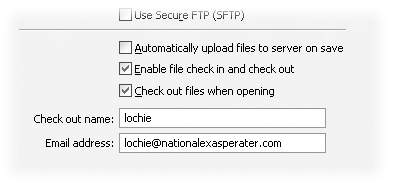 -
Click OK to return to the Manage Sites dialog box; click Done. The Manage Sites dialog box closes , and the Files panel opens. At this point, you're ready to connect to the Web server and transfer files. If you're the only person working on the site, Dreamweaver's Get and Put commands will do the trick (Section 16.2). If, however, you're part of a development team, use Dreamweaver's Check In and Check Out feature, described in Section 16.3, instead. 16.1.2 Setting Up a Remote Site over a Local Network If you're working on an intranet, or if your company's Web server is connected to the company network, you may also be able to transfer your Web files just as you'd move any files from machine to machine. Dreamweaver provides the same file transfer functions as with FTP, but setup is simpler. Follow steps 1 and 2 of the previous instructions; but in step 3, click the Remote Info category, and then choose Local/Network from the Access pop-up menu. Menus and fields for collecting your connection information appear in the Site Definition box (see Figure 16-3). Now click the folder icon next to the Remote Folder field. In the resulting dialog box, navigate to and select your site's remote root folder. On a local network, this folder functions as the root folder on your company's Web server (see Section 14.1.1.4), even though it's actually still within the walls of your building. (For differences on selecting root folders on Windows and Macs, see Section 1.3.1.) Wrap up with steps 10 and 11 of the previous instructions. At this point, you're ready to connect to the Web server and transfer files. Clicking the Refresh Remote File List Automatically box updates the list of files in the Files panel. Changes to the remote site, such as when someone adds a file, are listed automatically. Because automatic updating slows down the process of moving files to the remote site, however, you may want to deselect this option when you begin a session of moving many files. You can always refresh the file list manually by clicking the Refresh button on the Files panel (Section 14.1.5). 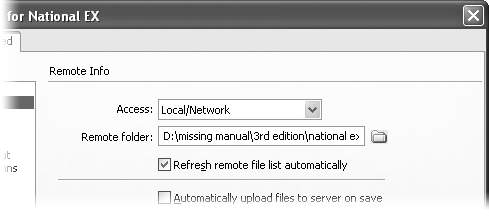 16.1.3 Setting Up a Remote Site with RDS RDS (Remote Development Service) is a feature of Macromedia's Cold Fusion Server. It lets designers work on Web files and databases in conjunction with a Cold Fusion application server. If you aren't using Cold Fusion, then this option isn't for you. To create a remote site in Dreamweaver that will work with RDS, follow steps 1 through 3 in Section 16.1.1. In step 4, click the Remote Info category, and then choose RDS from the Access pop-up menu (see Figure 16-1). The Remote Development Service, is a feature of the Cold Fusion application server. However, even if you use Cold Fusion, you may not be able to use RDS, since most Web hosting companies that offer Cold Fusion servers turn off RDS due to potential security problems. 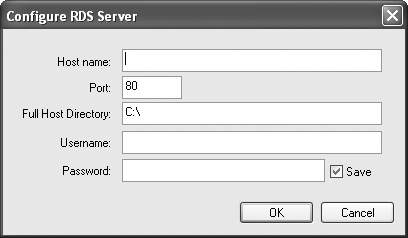 NOTE For more information on RDS, visit: www.macromedia.com/support/ultradev/programs/rds/rds02.html. The Site Definition window displays a version number, a short description, and a Settings button. Click Settings to open the Configure RDS Server window, shown in Figure 16-4. Fill in the dialog box as directed by your server administrator or help desk. 16.1.4 Setting Up a Remote Site with WebDAV Dreamweaver includes two other methods of accessing a remote site: WebDAV (an open-source program, meaning a collaborative effort by volunteer programmers all over the world) and Microsoft's Visual SourceSafe. Both technologies are designed to address one of the biggest problems when collaborating on a Web site: file management and version control. For instance, all kinds of havoc can result if two people edit a page simultaneously; whoever uploads the page to the Web server second winds up wiping out the changes made by the first person. What you need is a way to prevent more than one person from working on the same file at the same time. WebDAV, short for Web-based Distributed Authoring and Versioning, provides one such solution. It integrates seamlessly with Dreamweaver's Check In and Check Out feature, described in Section 16.3. NOTE Both WebDAV and SourceSafe are advanced options usually used by large organizations that require a good deal of technical expertise. Consider using them only if you have someone on staff who can guide you in setting them. (Or, of course, if you happen to be a technical wiz.) Both Microsoft Internet Information Server (IIS) and Apache Web Server can work with WebDAV. To find out if your Web server can handle WebDAV (and to find out the necessary connection information), consult your Web server's administrator. WebDAV, short for Web-based Distributed Authoring and Versioning, is a powerful tool for working on a large site with other people. It's built into several Web server packages. 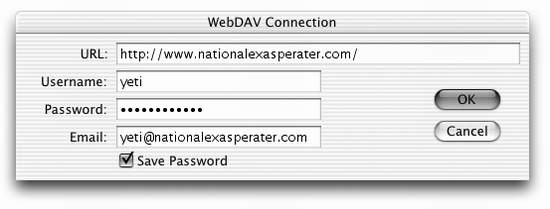 To create a remote site in Dreamweaver that will work with WebDAV, steps 1 through 3 in Section 16.1.1. In step 4, click the Remote Info category, and then choose WebDAV from the Access pop-up menu. The Site Definition window displays a version number, a short description, and a button labeled Settings. Click Settings to open the WebDAV Connection window, shown in Figure 16-5. In this dialog box, type the URL of the root directory on the WebDAV server (beginning with http:// ), your user name, email address, and password. (If you don't know these three bits of information, ask the server administrator or help desk.) Click OK. As a final step, turn on the Check Out Files when Opening checkbox in the Site Definition dialog box. Click OK, then Done. You're ready to connect to the Web server and transfer files, as described in Section 16.2. NOTE You can find more information on WebDAV at www.webdav.org/. 16.1.5 Setting Up a Remote Site with SourceSafe Microsoft originally created Visual SourceSafe for managing team software development. Like WebDAV, SourceSafe makes sure you don't accidentally stomp on someone else's hard work by overwriting a Web page they just modified. In addition, this sophisticated program tracks different versions of files and lets an administrator "roll back" to previous versions of a Web page, or even an entire site; it's the granddaddy of Undos. To take advantage of this power, however, you need a Visual SourceSafe (VSS) server and VSS database already set up. In addition, Windows users need to install Microsoft Visual SourceSafe Client version 6 on their PCs. NOTE The Visual SourceSafe option is not available to Mac users of Dreamweaver MX 2004. Once you've installed the VSS Client software, and you've created and defined a local site (see Section 14.1.1), you're ready to configure Dreamweaver for SourceSafe using the Site Definition window. Basically, you tell Dreamweaver where to find the SourceSafe database and how to sign on to the server. Once again, follow steps 1 though 3 in Section 16.1.1. But in step 4, click the Remote Info category, and then choose SourceSafe Database from the Access pop-up menu. In the resulting dialog box, click Settings to reveal the Open SourceSafe Database dialog box, shown in Figure 16-6. Dreamweaver supports Microsoft's Visual SourceSafe system. Many corporations use this powerful file-control system to control access to files in large projects involving many people. 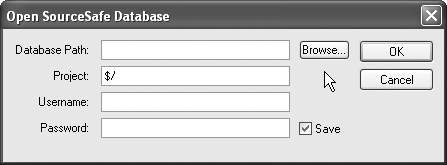 Click Browse to select the Visual SourceSafe (VSS) database file on your computer (or type in the file path, if you know it, into the Database Path field) ”the srcsafe.ini file that Dreamweaver uses to initialize SourceSafe. Then, in the Project field, fill in the name of the project within the VSS database that you wish to use as the remote root folder. (A VSS database can have many projects and Web sites listed in it. Make sure you enter the right project name for this site. If in doubt, contact the administrator of the Visual SourceSafe database.) Type your user name and password into the appropriate fields; again, ask the administrator for guidance. Click OK. But before dismissing the Site Definition dialog box, turn on Check Out Files when Opening, so that Dreamweaver's Check In and Check Out feature (see Section 16.3) will work with the VSS system. Click OK, then Done. You're ready to connect to the Web server and transfer files. Both WebDAV and SourceSafe use Dreamweaver's Check In and Check Out process, described in Section 16.3.1, for transferring files. |